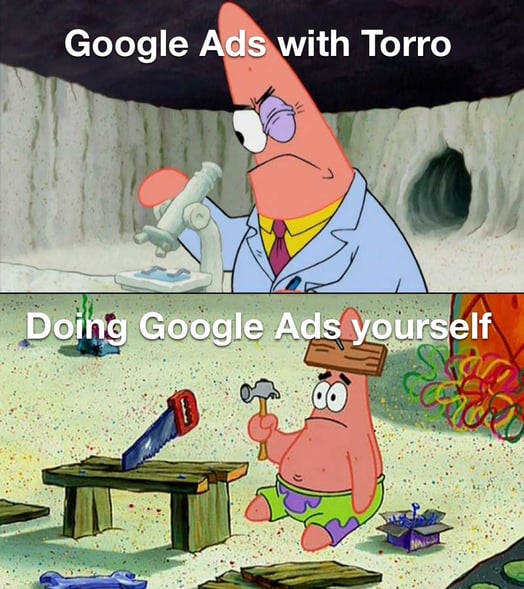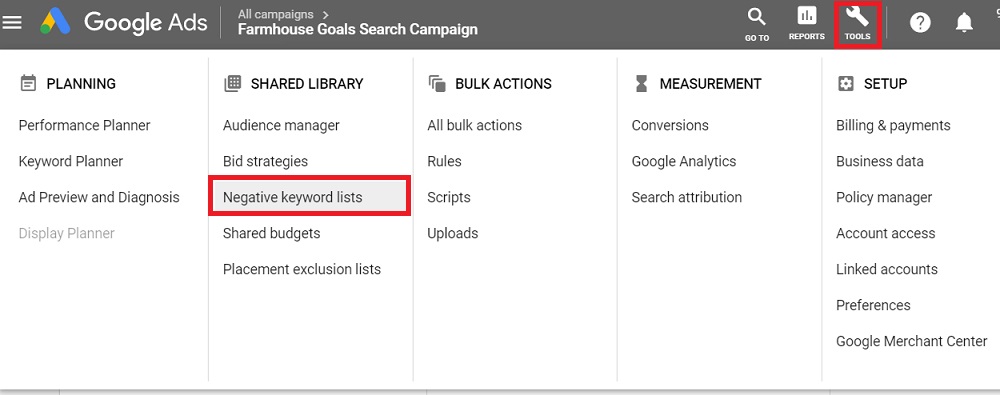The Ultimate Guide to Google Ads: 20 Do’s and Don'ts for Success
Mastering Google Ads is essential for achieving success in digital advertising. In this comprehensive guide, we will delve into 20 critical do's and don'ts that can make or break your Ads campaign. Equip yourself with these insights to navigate Google Ads like a pro (otherwise we're here to help).

Do’s: Maximize Your Ads Campaign Success
1. Conduct Comprehensive Keyword Research
Understanding your target audience's language is crucial for effectively reaching and engaging with them. Use tools like Google Keyword Planner and SEMrush to discover high-value, low-competition keywords that optimize your Google Ads campaign and improve your chances of success. By conducting comprehensive keyword research, you can create targeted ad copy that resonates with your audience and drives conversions. Don't underestimate the importance of understanding your audience's language. Utilize tools like Google Keyword Planner and SEMrush for comprehensive keyword research and uncover high-value keywords to drive the success of your Ads campaign.
2. Write Compelling Ad Copy
Craft compelling ad copy that resonates with your audience, using clear language and compelling CTAs. Tailor your messaging to address their needs, highlight benefits, and offer solutions. Keep your ad copy concise and easy to understand, avoiding jargon or complex language. Incorporate compelling CTAs to create urgency and drive user action. By following these guidelines, you can engage users, drive conversions, and achieve campaign success.
3. Optimize Ad Extensions
Utilize ad extensions to provide additional information, such as location, phone number, special offers, and customer reviews. By incorporating ad extensions, you not only increase the visibility and credibility of your ads but also enhance the overall user experience. Including location extensions allows potential customers to easily find your business and increases the likelihood of them visiting your physical store. Adding phone number extensions enables users to directly call your business with just a click, improving accessibility and driving more leads. Including special offers and promotions in your ad extensions can entice users to click on your ads, increasing the chances of conversions. Lastly, incorporating customer reviews and ratings can build trust and confidence in your brand, as users are more likely to trust the opinions of others. Overall, leveraging ad extensions is a powerful strategy to enhance your ads' performance, engage with your target audience, and drive campaign success.
4. Implement Negative Keywords
Regularly update your negative keyword list to optimize your Google Ads campaign and maximize ROI. By filtering out irrelevant traffic, you save money and ensure your ads reach the most relevant audience. Include negative keywords to prevent ads from appearing in irrelevant searches. Analyze the search terms report in Google Ads to identify irrelevant keywords and add them to your negative keyword list. This improves campaign performance by minimizing wasted clicks and increasing the quality and relevance of your traffic. Review and update your negative keyword list regularly to stay ahead and maximize the success of your Google Ads campaign.

Here's 53 keywords that we'll typically recommend adding to any new campaign on the negative keyword list:
| About | Affordable | Amazon | Article | Articles |
| Blog | Case Study | Cheap | Classes | Clubs |
| Code | Comparison | Conference | Courses | Craigslist |
| Definition | DIY | Documents | Ebay | Employers |
| Employment | Examples | Forums | Free | Guide |
| Guides | Hiring | Hobby Lobby | How Can | How Does |
| How To | Images | Internship | Jobs | News |
| Newsletter | Open Source | Overstock | Presentations | Price |
| Quotes | Reports | Reviews | Salary | Templates |
| Training | Tutorial | University | Used | Video |
| What Are | What Is | Where Can |
5. Track and Analyze Performance
Utilize tools like Google Analytics and Ads' native tools to monitor your Google Ads campaign's performance. Pay attention to key metrics like CTR and CPC to assess ad effectiveness and make data-driven decisions. Consider other metrics like conversion rate and ROAS for deeper insights and optimization. Continuously monitor and adjust your campaign based on gathered insights for exceptional results.
Don’ts: Avoid These Ads Pitfalls
6. Neglecting Mobile Users
Optimizing your ads for mobile devices is crucial in today's digital age. With the increasing use of smartphones and tablets, neglecting mobile optimization risks losing potential customers and hindering ad campaign success. Ensure your ad design is responsive, pay attention to loading times, and consider the mobile user experience. By tailoring your ads to meet the needs and preferences of mobile users, you can tap into a vast and growing audience and drive the success of your digital advertising objectives.
7. Ignoring Ad Position and Quality Score
Monitor ad position and improve Quality Score by optimizing relevance, landing page experience, and CTR. Ad position attracts user attention and clicks, so focus on relevance, landing page quality, and CTR to increase ad position. Optimize landing page experience for better user experience and conversions. A high CTR indicates ad relevance, so write compelling copy, use relevant keywords, and persuasive CTAs. Regularly monitor and optimize to improve overall campaign performance and achieve better results.
8. Setting and Forgetting
Regularly reviewing and adjusting your Ads campaign is crucial for maximizing success in the ever-evolving digital advertising landscape. Stay proactive and responsive to market conditions, user behavior, and emerging trends. Make timely adjustments to ad copy, targeting, and overall strategy to ensure effectiveness and relevance. Stay up to date with industry trends, competitor activity, and changes in consumer behavior to optimize campaign performance. Analyze performance data to reallocate budget to high-performing areas and maximize ROI. Continuously optimize your campaign for exceptional results.

9. Overlooking Geo-Targeting
Utilize geo-targeting to show relevant ads to specific locations, maximizing their effectiveness. Focus your advertising budget on areas where your target audience is located, avoiding irrelevant clicks and increasing the chances of conversions. Customize your messaging based on the location to address unique needs and preferences, driving better results. Geo-targeting is a powerful strategy that maximizes ad relevance and improves campaign effectiveness in digital advertising.
10. Using Broad Match Keywords Excessively
To optimize your Google Ads campaign, carefully consider your keyword matching options. Limit the use of broad match keywords and focus on phrase match or exact match to drive targeted traffic. Phrase match shows ads for searches with the specified phrase, while exact match ensures ads only appear for exact keyword matches. By using these options, you have more control over ad relevancy, improving click-through rates and conversions. Regularly review and refine your keyword strategy based on ad performance to achieve your digital advertising objectives.

Advanced Strategies: Elevate Your Ads Game
11. Employ Remarketing Techniques
Utilize remarketing to reconnect with potential customers who have shown interest in your brand. By creating custom audiences based on specific actions or page visits, you can target them with tailored ads that remind them of their previous interaction. Segment your audience based on behavior and interests to deliver highly targeted ads. Create compelling ad creatives that offer value, address concerns, and highlight customer reviews. Continuously monitor and optimize your remarketing campaigns to maximize conversions and drive success.
12. Test and Optimize Landing Pages
A/B testing compares different landing page versions to determine which one converts better. Create variations of your landing page, focusing on conversions rather than clicks. Test elements like headlines, copy, calls-to-action, layout, and visuals. Divide traffic evenly, track metrics, and analyze results. Implement the winning version as your default landing page and continue testing to improve conversions. Regularly refine and optimize your landing pages for the best advertising campaign results.
13. Leverage Ad Scheduling
Maximize ad visibility and impact by customizing ad schedules to reach your audience at optimal times. Analyze online behavior patterns to determine peak engagement periods. By controlling when ads appear, you can increase chances of capturing attention, driving more clicks and achieving better results.
Critical Mistakes to Avoid: Don't Let These Sink Your Campaign
14. Mismanaging Budget
Setting realistic budgets, monitoring performance data, and making informed decisions about budget allocation are essential for successful Google Ads campaigns. Regularly review campaign performance to identify low-performing campaigns and reallocate budget to optimize overall performance. By setting appropriate budgets and avoiding excessive spending on underperforming campaigns, you can maximize your return on investment and drive the success of your digital advertising strategy.

15. Disregarding Ad Copy Relevance
To succeed in your Google Ads campaigns, ensure that your ad copy aligns with relevant keywords. Conduct thorough keyword research and strategically incorporate them into your ad copy. Address the needs of your target audience and keep the messaging clear and concise. By making your ad copy highly relevant, you can improve visibility, click-through rates, and the overall user experience, leading to higher conversions and campaign success.
16. Ignoring Conversion Tracking
Implementing conversion tracking is crucial for optimizing your Google Ads campaign. By tracking conversions, you can gain valuable insights into the effectiveness of your ads, keywords, and landing pages. This allows you to allocate your budget effectively, focus on strategies that generate the best return on investment, and make data-driven adjustments to improve performance. Use tools like Google Analytics or the conversion tracking feature within Google Ads to accurately measure and analyze conversions. Don't overlook the importance of conversion tracking – it's essential for driving success and maximizing your ROI.
![]()
17. Failing to Optimize for Voice Search
Optimize your digital advertising strategy for voice search by incorporating long-tail keywords and phrases that mimic natural language. Craft your ad copy to directly address user queries in a conversational tone. By embracing this emerging trend, you can capture the attention of voice search users and drive more conversions.
18. Dismissing Responsive Ads
Responsive ads are a game-changer in digital advertising, automatically adjusting to fit any platform or device for a seamless experience. They save time and effort by dynamically adapting to available ad spaces, ensuring visually appealing and engaging ads. With responsive ads, you can reach your audience on any device, maximize visibility, and gather valuable data to improve your advertising strategy. Embrace responsive ads to optimize your campaigns and provide a seamless experience for your audience.
19. Not Regularly Reviewing Search Terms Report
Regularly reviewing the Search Terms Report in Google Ads is crucial for optimizing your campaign. It helps you identify new keyword opportunities and add them to your existing list. Equally important is identifying irrelevant search terms and adding them as negative keywords to prevent your ads from showing up in irrelevant searches. Keep updating your negative keyword list to ensure your ads are shown to the most relevant audience and maximize campaign success. Stay proactive, monitor and adjust your campaign based on insights from the Search Terms Report for exceptional results.
20. Avoiding SKAGs (Single Keyword Ad Groups)
Implementing SKAGs in your Google Ads campaign can significantly improve ad performance and Quality Score. By creating hyper-targeted ads with relevant copy, you increase the chances of capturing your audience's attention and driving conversions. SKAGs involve creating separate ad groups for each keyword, allowing for precise customization and higher relevance. This strategy also provides more control over Quality Score, improves ad tracking, and allows for data-driven optimization. Don't overlook the power of SKAGs in achieving exceptional results.
Conclusion
To excel in your Google AdWords campaign, stay updated with industry trends and best practices. Implement advanced strategies like remarketing, optimize landing pages, and leverage ad scheduling. Avoid critical mistakes such as mismanaging your budget, disregarding ad copy relevance, and ignoring conversion tracking. Optimize for voice search, embrace responsive ads, regularly review the Search Terms Report, and implement Single Keyword Ad Groups (SKAGs) for improved ad performance. Continuously learn, adapt, and optimize your campaign for exceptional results.

While reviewing SEM options with Google Ads, don't forget about your website whether it's Wordpress or Hubspot CMS, we'd love to help with your foundation as well and where users are directed from your ads.




